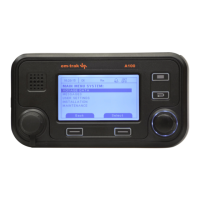Operation
Page 29
3.19 Inland AIS
The transceiver supports both standard ‘high seas’ operation and ‘Inland AIS’ operation. Inland AIS is an
extension of AIS intended for use on board vessels navigating Inland waterways.
During installation the transceiver will be configured appropriately for either high seas or inland operation.
When the transceiver is configured for inland operation the ‘IL’
icon will be displayed on the status bar (see
section
3.3.1). Information on enabling / disabling inland AIS mode along with additional configuration required
for inland operation can be found in section 4.9.
3.19.1 Own vessel and voyage data display in Inland AIS mode
Additional own vessel and voyage related data is displayed on the main operating screens in inland AIS mode.
The following additional information is displayed on the own vessel data screen (as described in section
3.6):
● Blue sign status is displayed as either ‘Yes’ (the sign is set), ‘No’ (the sign is not set) or ‘not available’
when the blue sign switch is not installed. If a blue sign switch is installed it should be manually
switched to the appropriate setting during navigation (see section
3.19.4).
● The IMO number is set to ‘0’ or ‘0000000’ when operating in inland AIS mode.
● The dimensions of the vessel are set to the maximum rectangular size of the convoy when operating
in inland AIS mode.
● The destination is displayed as a UN location code and ERI terminal code.
● The ENI (unique European Vessel Identification Number) for the vessel is shown.
● The ship (or combination type) is shown using an ERI classification code. A table of ERI codes is
provided in section
9 for reference.
● The load status of the vessel is displayed as ‘Loaded’ or ‘Unloaded’.
● The number of crew, passengers and other shipboard personnel will be displayed.
3.19.2 Target vessel details display in Inland AIS mode
Additional detail relating to target vessels is available when operating in Inland AIS mode. The additional
information is only displayed for target vessels which are also equipped with an Inland AIS transceiver and are
transmitting inland AIS data.
The target vessel details display described in section 3.5 will show the following additional data:
● Blue sign status is displayed as either ‘Yes’ (the sign is set), ‘No’ (the sign is not set) or ‘not available’.
● The IMO number is not shown for Inland target vessels, the ENI (unique European Vessel
Identification Number) for the vessel is shown instead.
● The displayed dimensions of the vessel are the maximum rectangular size of the convoy.
● The target vessel destination is displayed as a UN location code and ERI terminal code.
● The ship (or combination type) is shown using an ERI classification code. A table of ERI codes is
provided in section
9 for reference.
● The load status of the vessel is displayed as ‘Loaded’ or ‘Unloaded’
● Quality of speed, course and heading information will be shown as ‘high’ when the target vessel is
using an approved sensor to generate this data, or low if the data is derived from internal GNSS only.
● The number of crew, passengers and other shipboard personnel will be displayed.
3.19.3 Setting voyage data in Inland AIS mode
Additional voyage related information is required for Inland operation along with some changes to the standard
AIS configuration. The following additional information must be entered into the AIS transceiver:
● The vessels load status as ‘loaded’ or ‘unloaded’.
● The number of blue cones or blue flag status for the cargo (1, 2 or 3 blue cones, or blue flag).
● The static draught of the vessel to the nearest centimetre.
● The air draught of the vessel to the nearest centimetre.

